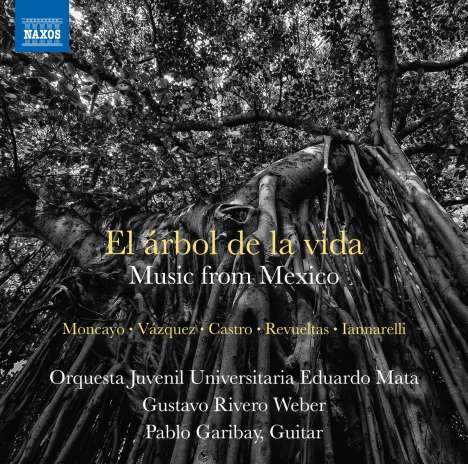El arbol de la vida auf CD
El arbol de la vida
Herkömmliche CD, die mit allen CD-Playern und Computerlaufwerken, aber auch mit den meisten SACD- oder Multiplayern abspielbar ist.
Lassen Sie sich über unseren eCourier benachrichtigen, falls das Produkt bestellt werden kann.
Moncayo: Huapango
+Vazquez: El arbol de la vida
+Castro: Minuetto op. 23
+Revueltas: La noche de los mayas
+Iannarelli: El ultimo cafe juntos
- Künstler:
- Pablo Garibay (Gitarre), Orquesta Juvenil Universitaria Eduardo Mata, Gustavo Rivero Weber
- Label:
- Naxos
- Aufnahmejahr ca.:
- 2018
- UPC/EAN:
- 0747313390274
- Erscheinungstermin:
- 11.1.2019
- Serie:
- Naxos Latin American Classics
Ähnliche Artikel
Der Impuls der mexikanischen Revolution beflügelte die Verwendung indigener Melodien in einer neuen und originellen Welle von Musikkompositionen, die die Abhängigkeit von europäischen Modellen lockerten. José Moncayos ansteckend fröhlicher Huapango, eines der bekanntesten Werke Mexikos, ist in seinem ausgeprägten nationalen Charakter tief in der Volksmusik verwurzelt. Silvestre Revueltas' La noche de los mayas ist eine aus der Filmmusik abgeleitete symphonische Suite, in der mexikanische Perkussionsinstrumente auf einfallsreiche Weise eingesetzt werden. Der Prozess der Verbindung von folkloristischen Einflüssen mit klassischen Techniken setzt sich bis heute mit Hebert Vázquez' El árbol de la vida fort, der den als Sohn bekannten Folkstil verwendet.
Product Information
The impetus of the Mexican Revolution galvanised the use of indigenous melodies in a new and original wave of musical compositions that loosened dependence on European models. José Moncayo’s infectiously joyful Huapango, one of Mexico’s best-known works is, in its distinct national character, deeply rooted in folk music. Silvestre Revueltas’s La noche de los mayas is a symphonic suite derived from film music that employs Mexican percussion instruments in a vividly inventive way. The process of linking folk influence with classical techniques continues to the present day with Hebert Vázquez’s El árbol de la vida which uses the folk style known as the son.
Disk 1 von 1 (CD)
-
1 Jose Pablo Moncayo: Huapango (1941)
-
2 Hebert Vázquez: El árbol de la vida (für verstärkte Gitarre und Orchester) (2015)
-
3 Ricardo Castro: Menuett op. 23 (1904)
La Noche de los Mayas (1939)
-
4 1. Noche de los mayas (Molto sostenuto)
-
5 2. Noche de jaranas (Scherzo)
-
6 3. Noches de Yucatán (Andante espressivo)
-
7 4. Noches de encantamiento (Thema mit Variationen)
-
8 Simone Iannarelli: El último café juntos (Stück für Gitarre und Streichorchester nach Italian Coffee Nr. 5 "L'ulstimo caffè insieme) (2007)








